Hisense RQ560N4WC1 Review
Hisense RQ560N4WC1 Review
This fridge freezer is really cool

Verdict
Pros
- Stylish stainless-steel effect finish
- Flexible independent freezing
- Stable temperature in fridge and main freezer
- Great LED lighting throughout
- Water container and dispenser
- Low running costs
- Outstanding value
Cons
- Slightly awkward touch controls
- Basic salad drawers
- Stiff sliders on freezer drawers
Key Specifications
- Review Price: £750.00
- A+ energy rated
- frost-free
- 80cm-wide, 4-door fridge freezer
- H181 x W79.4 x D70cm
- 289 litres fridge space
- 2 x 71 litres freezer space
What is the Hisense RQ560N4WC1?
Promising big capacity, flexible features and great performance at an affordable price, Hisense’s new four-door French-style fridge freezer is easy on the eye and the wallet. From the stainless-steel effect finish and stylish design, to the flexible interior storage and hefty 80cm width, the new RQ560N4WC1 looks and feels as premium as its price would suggest. Plus, it even offers a digital LED display with touch controls and a non-plumbed water dispenser on the door.
Its two frost-free freezer compartments can be set at independent temperatures and LED lighting throughout all three compartments should ensure lost peas are a thing of the past.
Best American-style fridge freezers
Hisense RQ560N4WC1 – How does it look?
Hisense’s RQ560N4WC1 is a big, imposing appliance that’s going to make quite the statement in your kitchen. The four doors, near-80cm width, stainless-steel effect finish, water dispenser and sophisticated-looking touch controls shout out a price point that’s way above its relatively humble sub-£800 ticket. And if the stainless-steel doors aren’t for you, a more sedate – although no less stylish – black version is also available.
Related: Best Fridge Freezers
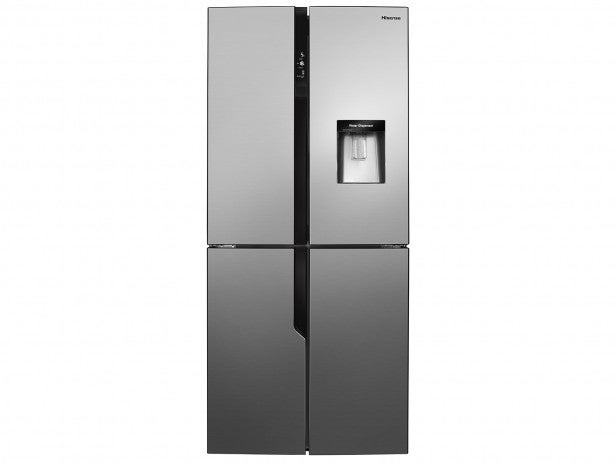
The RQ560N4WC1 is an update on the Hisense FMN432A20C four-door model we reviewed very favourably late last year – and has even more to offer. While almost identical in size and total capacity, the new kid on the block adds the water dispenser, new chrome trim, a black-finish option and a slight tweak of the interior furniture to account for the water container.
Moreover, there haven’t been any major corners cut to achieve this price point, no doubt thanks in part to the sheer scale of Hisense’s operation as one of the world’s largest domestic appliance makers. The stainless-steel effect finish is lacquered to reduce the appearance of finger marks, plus the inset handles feel nicely solid in the hand. The black gloss panel down the middle of the appliance seamlessly integrates the touch controls and blue LED display panel.
Like its predecessor, the touch controls can be a little tricky to master since there’s no obvious area to touch and the default setting is locked. Once figured out, however, you can set the target temperatures of the three separate compartments, as well as Super Freeze, Super Cool and low-energy holiday mode functions.
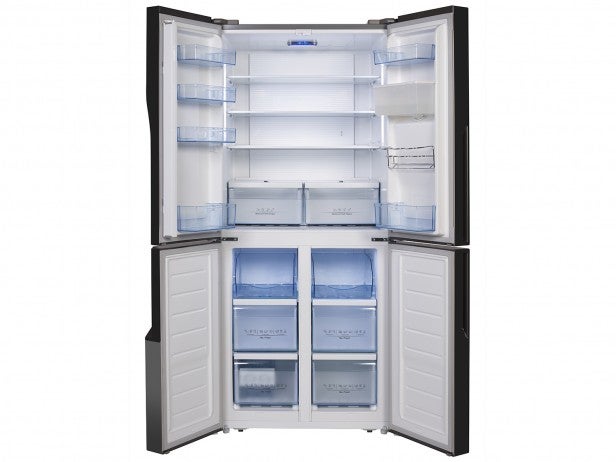
This refrigerator configuration is loosely termed “French Style”, with a wide refrigerator space at the top featuring doors that open like a wardrobe. The fridge is properly cavernous at 289-litres, with four full-width shelves and two big salad drawers.
The left door offers four pockets, while the right side has one large bottle pocket, a smaller top pocket, a chrome wire bottle rack and the large water dispenser container. This is easily removed for filling. The lever-operated dispenser on the outside of the right-hand door has a handy lock-switch to stop accidental spillages.
There isn’t much scope for internal shelf or door-pocket adjustment, but all can be removed to make space for larger items, if required. The whole fridge area is supremely well illuminated by two side-mounted bright white LED strips. These do a great job of lighting the whole fridge, even when its packed out with produce.
At the bottom, the two independent freezer compartments can be run at different temperatures to suit the contents. The left-hand side is a traditional freezer, with a temperature range of -15 to -25oC, while the right-hand compartment can be set from -5 to -18oC. That covers all the bases from traditional freezer (-18 degrees) to soft-frozen foods such as ice cream and deserts (-12oC) and even short-term fish and meat storage (-5oC). We also found the -5oC setting ideal for speed-chilling wine and beer for summer parties.
Both freezers offer three drawers, the upper of which is an open-style bin for easy access. The lower left drawer houses a removable “twist and serve”-style ice cube maker and both compartments offer LED illumination – which we so rarely see in a freezer. Top marks all round, Hisense.
Hisense RQ560N4WC1 – How much can you fit in?
Near 80cm wide, four-door fridge freezers are few and far between, with many appliances in this category opting for a 90cm width. The smaller width gives away little in terms of storage capacity and will make it a whole lot easier to integrate the appliance into smaller kitchens. It’s also a handy 70cm deep, slightly shallower than some larger appliances, so it won’t stick out past the end of your worktop quite so much.
The doors are fairly evenly matched in height, but the freezer’s additional wall thickness for insulation, the divider between the two compartments and the bottom-mounted compressors mean that the actual capacity split is a pretty traditional 70:30. That equates to 289 litres of fridge space and 142 litres of freezer space – the latter divided evenly between the two compartments. That’s a whole lot of cooling space.
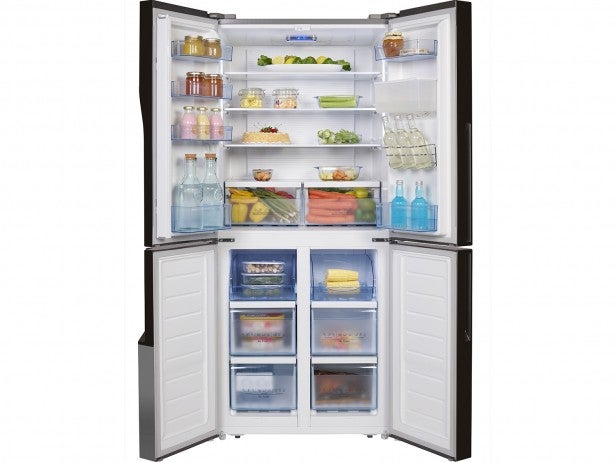
The fridge’s four full-width glass shelves with spill-proof edges provide scope for wide items such as baking trays or large plates. The even distance between the shelves isn’t ideal, though – and for those with taller items to store in the main compartment, you’ll probably have to remove one of the shelves.
The salad drawers are fairly large, albeit slightly truncated by the lowest door pocket and total 70cm depth of the appliance. When fully loaded, they do require a bit of a firm tug on their basic plastic sliders. The humidity control on each is a simple vent slider.
The door pockets are huge. The lowest ones will hold a couple of 2-litre milk cartons each with ease. The good depth on the upper pockets means you’ll never be short of space for jars. We missed a cover on any of the door pockets for cheese and butter, but that’s a personal preference.
What we really liked, however, was the wire bottle rack on the right-hand door. We love that they’re on the door, rather than taking up valuable space in shelf area.
The top freezer drawers with their open front took a little while to get used to. The jury was out on their practicality at first, as you’d clearly be able to stuff more in them if they had full fronts like traditional drawers. Yet the easy-access to regular items was handy, even more so when you consider they were so well illuminated from above by the freezer LEDs.
Given the sheer size of the freezer overall, though, these open top bins actually proved super-handy, so they got a thumbs-up in the end. The drawers below were fairly basic and, like the salad bins in the fridge, take a good solid tug to open and close when fully loaded.
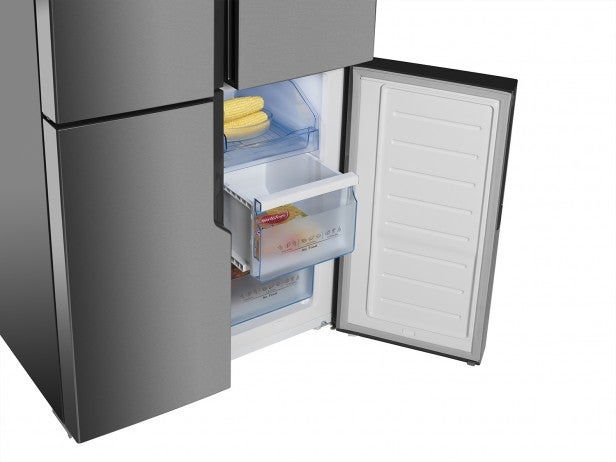
Despite the scope and flexibility of the dual control freezers, we suspect most people will default to setting the right side freezer to -18oC and simply use it as traditional freezer space. I say this as we found that, in reality, 71 litres of day-to-day freezer space is pretty tight for even a small family. So while the idea of soft-scoop ice cream is appealing, the reality is that 142 litres of proper freezer space over six drawers is just much more practical.
Hisense RQ560N4WC1 – How noisy is it?
It’s not as noisy as the energy label suggests. Just like last year’s model, this new Hisense runs traditional compressor motors but keeps them very well sound-insulated. When the machine is backed up against a wall with kitchen cabinets on either side, it will be very quiet indeed.
We measured just 39dB on average, with an occasional peak to 40-41dB. That 39dB average is a superb figure and up there with some of the more affluent cutting-edge tech fridge freezers that use linear compressor motors. As with all traditional compressors they’ll become a little nosier over time, but only by a couple of dB… probably just about enough to get up to the figure of 43dB stated on the energy label.
Hisense RQ560N4WC1 – How well does it perform?
Filling huge fridge freezers with real produce is always a challenge, but Jackie did point out that we do now regularly get our five-a-day of fruits and veggies. We loaded the fridge section of the RQ560N4WC1 with 14.5kg of fresh food (0.5kg per 10l of space) and each of the freezers with 7kg (1kg/10l) frozen food.
In addition, we put 2 litres of room-temperature water in the left side freezer to measure fresh-to-frozen time, and to discover how the RQ560N4WC1 would cope in the event of a power failure. We set the fridge to 4oC, the left-hand freezer to -18oC and the right-hand freezer to -12oC… just in case friends came over with a week’s supply of Carte D’Or.
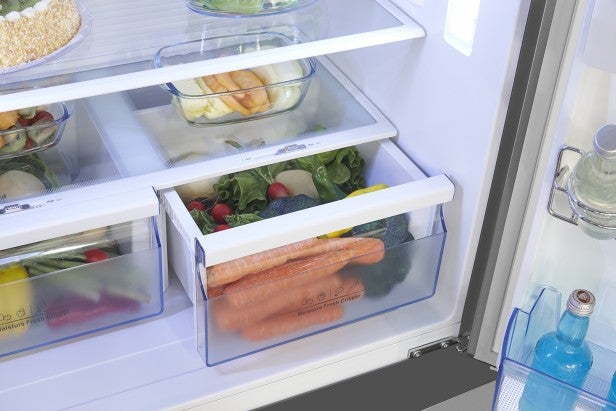
Just like its predecessor, the new Hisense performed very well, turning in a solid set of technical results – which is particularly impressive given its relatively budget price for its size.
The large fridge fared very well, with a narrow spread of temperatures from top to bottom and a mean average of pretty much 4oC. Both salad drawers averaged just below 4oC, which is ideal for salads and fresh fruit, and varied by just +/- 1oC throughout.
Only the top shelf struggled to remain as stable as the rest of the fridge compartment, with short-term peaks up to 7oC and chilling that dipped as low as -2oC, albeit for just a few minutes. This could potentially cause mild frost damage to soft fruits, but since most people tend to store bottles and jars up there, it’s unlikely to be a big issue.
Both freezer compartments proved equally solid performers, with the lower temperature left-hand freezer once again offering class-leading performance at the price. It averaged near spot on -18oC and remained within a few degrees of average throughout the test. Fresh to frozen took a while – at close to 20 hours – so using the fast-freeze option to freeze down large quantities of fresh food quickly would be advisable.
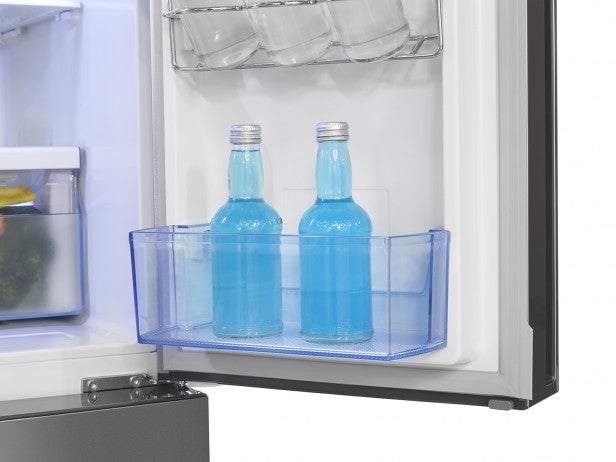
The right-hand side of the freezer proved a little more variable, but still very good compared to the market average at this price. The top drawer was the most variable at +3/-7 degrees on its -12oC average, while the lowest drawer fared better with just a +1/-4 degree waver from its -14oC average.
In the three-hour fail test the RQ560N4WC1 once again delivered an excellent result for a relatively affordable four-door appliance. The left-hand freezer crept up around 6oC over the three hours, so easily freezer-safe (food not getting exposed to air temperature above 0oC) for comfortably more than 12 hours of power outage.
The right side went up about the same during the test, but if you were running at -12oC, you’d be unlikely to be storing critical foods such as meat and chicken anyway, so its hardly going to be an issue. Besides, power cuts are the best excuse there is to eat ice cream.
HiSense RQ560N4WC1 – How much will it cost to run?
Bigger fridge freezers such as the RQ560N4WC1 have to work very hard to achieve an A+ (or better) energy rating due to the larger surface area of the appliance taking on heat from the surrounding kitchen. We set up our test fridge-freezers in an environmental chamber kept at 18-19oC to imitate an average UK kitchen. We run the unit for several days, opening each compartment six times per day.
Given the very good fail-test results – which suggest excellent insulation – it came as no surprise that this Hisense easily lived up to its A+ energy billing. Over the course of a year, we calculated it would use around 290kWh of electricity or approximately £43 at 15p/kWh – which would actually make it closer to A++ for the size. There will be some variation here, depending on the temperature at which you set the right-hand freezer, but we’d estimate that even at -18oC, the RQ560N4WC1 would use somewhere between the 290kWh we measured and the 373kWh stated on the energy label.
As with all fridges, if you have a hot kitchen or a family that are accessing the fridge and freezer all day long, these figures will climb significantly. However, in our repeatable base-line energy tests this Hisense came out very well indeed.
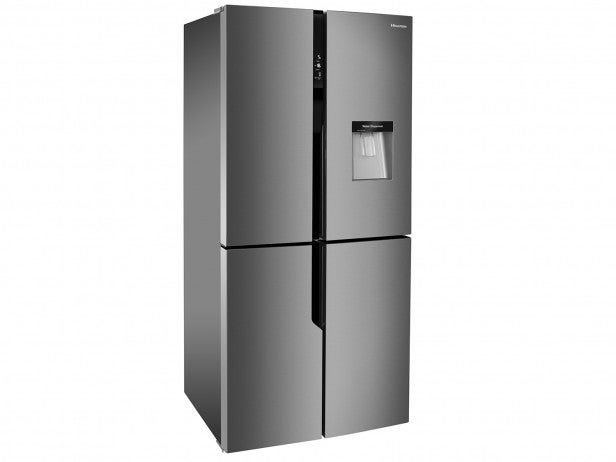
Should I buy the HiSense RQ560N4WC1?
Last year we said Hisense’s FMN432A20C offered great features and impressive performance at a very attractive price. The new RQ560N4WC1 builds on the four-door French-Style theme with outstanding flexibility, excellent lighting in the fridge and freezer, and a new chilled-water container with handy dispenser on the front door.
The performance and energy efficiency is right up there with the old model and, at this price, all we can really criticise is the slightly odd logic of the digital controls and basic drawer runners making for rather stiff drawer access. Once again, Hisense has come in with a great product at an outstanding price.
Verdict
Good overall performance and a stylish design make this a superb choice for those seeking a large fridge freezer.


